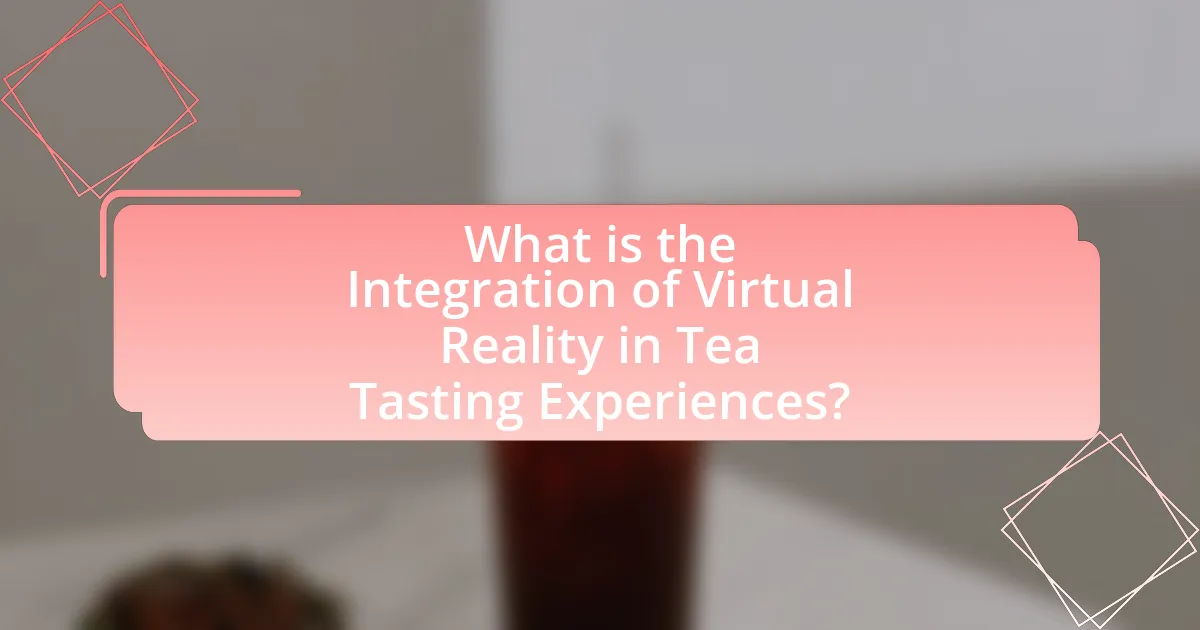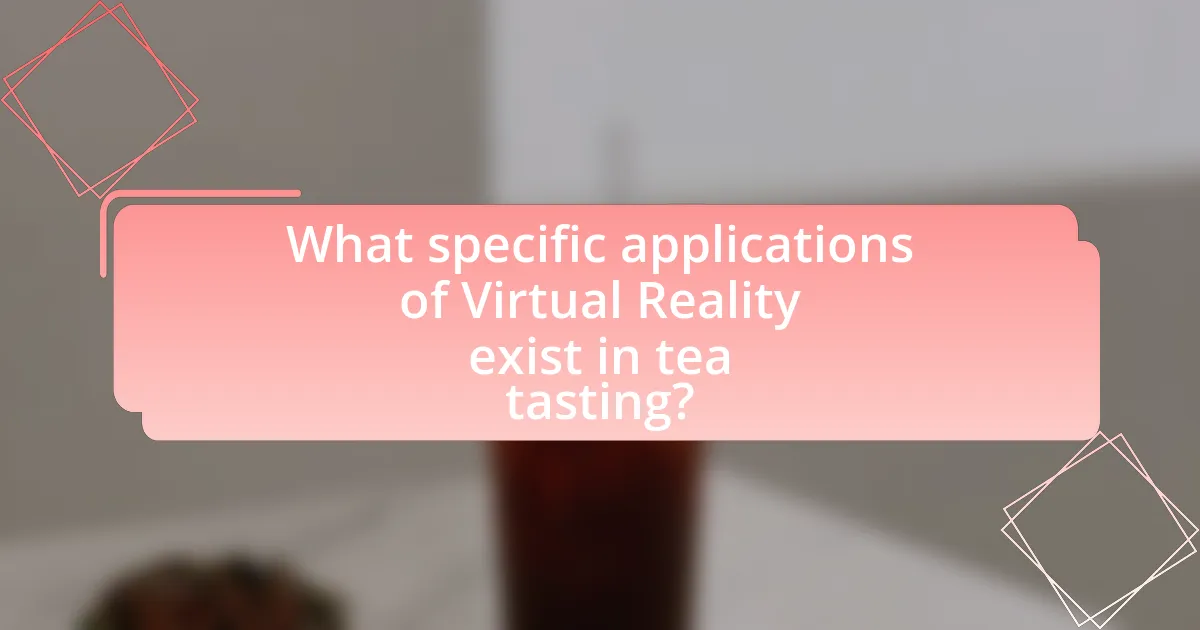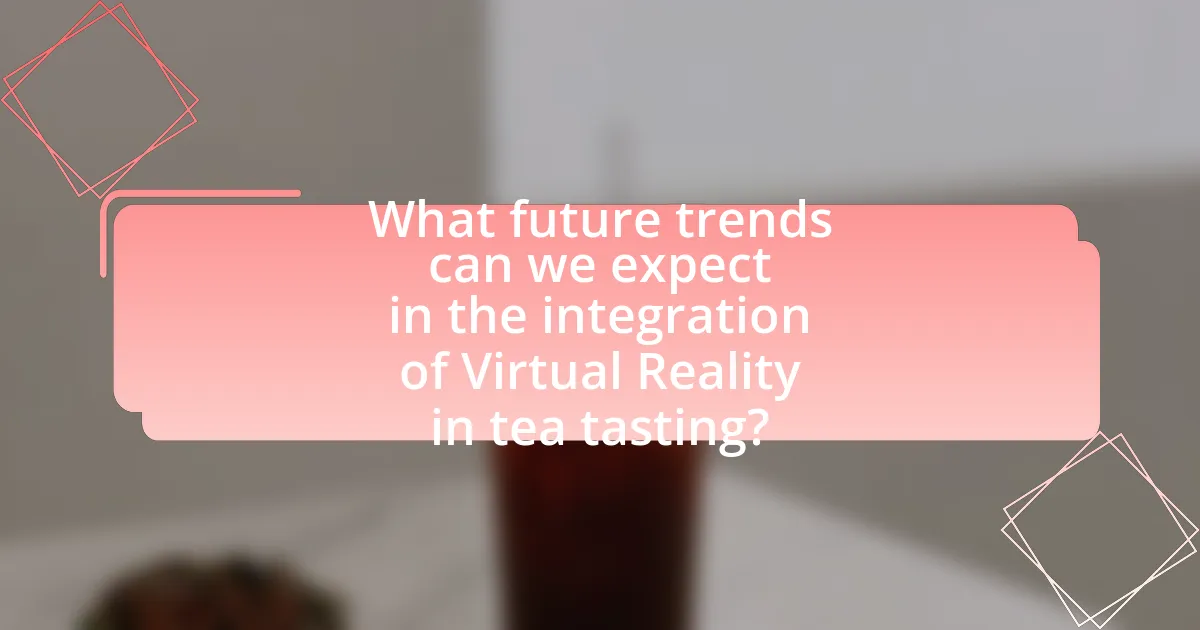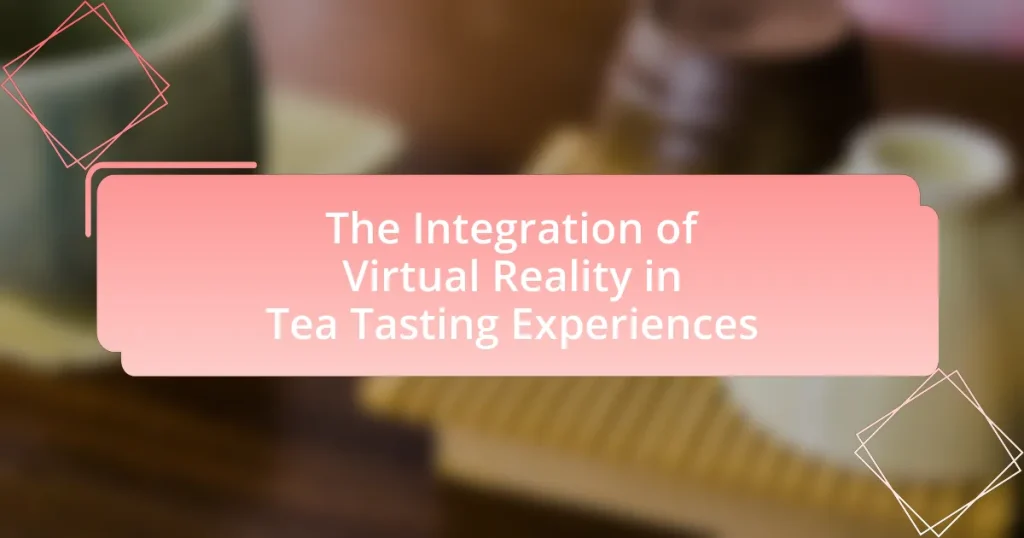The integration of virtual reality (VR) in tea tasting experiences significantly enhances sensory engagement by immersing participants in simulated environments that replicate tea cultivation and tasting processes. This article explores how VR technology enriches the tea tasting experience through sensory immersion, the historical developments leading to its adoption, and the various technologies involved in creating virtual tea tasting environments. It also examines the potential benefits of VR for consumer education, customer engagement, and the challenges faced in implementation. Additionally, the article discusses future trends and best practices for conducting successful virtual tea tastings, emphasizing the role of storytelling and emerging technologies in enhancing the overall experience.

What is the Integration of Virtual Reality in Tea Tasting Experiences?
The integration of virtual reality in tea tasting experiences enhances sensory engagement by immersing participants in a simulated environment that replicates tea cultivation and tasting. This technology allows users to explore tea gardens, learn about the tea-making process, and experience the flavors and aromas of different teas in a virtual setting. Studies have shown that immersive experiences can significantly improve the perception of taste and aroma, as participants are more likely to engage their senses fully when in a virtual environment. For instance, a study published in the journal “Food Quality and Preference” found that virtual reality can influence taste perception by creating a more engaging context for tasting.
How does Virtual Reality enhance the tea tasting experience?
Virtual Reality enhances the tea tasting experience by immersing participants in a simulated environment that replicates the sensory aspects of tea cultivation and tasting. This technology allows users to virtually visit tea plantations, interact with the tea-making process, and engage with the cultural context of tea. Studies have shown that immersive experiences can significantly increase sensory engagement, leading to heightened appreciation and enjoyment of the tea being tasted. For instance, a study published in the journal “Food Quality and Preference” found that sensory immersion can enhance flavor perception and emotional responses, making the tasting experience more memorable and enjoyable.
What technologies are involved in creating virtual tea tasting environments?
Virtual tea tasting environments are created using technologies such as virtual reality (VR), augmented reality (AR), sensory simulation, and haptic feedback systems. VR technology immerses users in a digital space where they can experience tea tasting through 3D environments that replicate tea gardens or tasting rooms. AR enhances this experience by overlaying digital information about tea varieties and brewing techniques onto the real world. Sensory simulation technologies, including scent dispensers, recreate the aroma of different teas, while haptic feedback systems provide tactile sensations, such as the warmth of a teacup. These technologies collectively enhance the authenticity and engagement of virtual tea tasting experiences.
How does sensory immersion play a role in virtual tea tasting?
Sensory immersion enhances virtual tea tasting by engaging multiple senses, creating a more authentic experience. In virtual environments, users can experience visual elements like the tea’s color and texture, auditory cues such as the sound of boiling water, and olfactory simulations through scent technology. Research indicates that immersive experiences can significantly improve user satisfaction and retention of information, as demonstrated in studies on virtual reality applications in culinary arts. For instance, a study published in the journal “Food Quality and Preference” found that sensory immersion in virtual settings can increase the perceived quality of food experiences, including beverages like tea. This multi-sensory engagement allows participants to connect more deeply with the tasting process, enhancing their overall enjoyment and understanding of the tea.
What are the historical developments leading to this integration?
The historical developments leading to the integration of virtual reality in tea tasting experiences include advancements in virtual reality technology, the rise of experiential marketing, and the growing interest in immersive consumer experiences. In the 1990s, the emergence of affordable VR hardware and software laid the groundwork for its application in various fields, including food and beverage. By the early 2000s, companies began exploring virtual reality as a tool for enhancing customer engagement, particularly in industries focused on sensory experiences. The increasing popularity of tea culture and the demand for innovative tasting experiences further propelled the integration of VR, as brands sought to differentiate themselves in a competitive market. This convergence of technology and consumer trends has led to the development of virtual tea tasting sessions that allow participants to engage with the sensory aspects of tea in a novel and immersive way.
How has technology evolved in the tea industry?
Technology in the tea industry has evolved significantly through the integration of advanced processing techniques, precision agriculture, and virtual reality applications. Modern processing methods, such as automated withering and rolling machines, enhance efficiency and consistency in tea production. Precision agriculture employs data analytics and IoT devices to monitor soil conditions and optimize irrigation, leading to improved crop yields. Additionally, virtual reality has emerged as a novel tool for tea tasting experiences, allowing consumers to immerse themselves in the origins and flavors of different teas, thereby enhancing their appreciation and understanding of the product. This evolution reflects a broader trend of technological adoption aimed at improving quality, sustainability, and consumer engagement in the tea industry.
What milestones have marked the use of virtual reality in food and beverage experiences?
Milestones in the use of virtual reality (VR) in food and beverage experiences include the introduction of immersive dining experiences, the development of VR applications for virtual wine and tea tastings, and the integration of VR in culinary education. The first significant milestone occurred in 2016 when restaurants began offering VR dining experiences, allowing customers to engage with their meals in a multi-sensory environment. In 2018, companies like Oculus and Google launched VR applications specifically designed for virtual wine tastings, enabling users to explore vineyards and learn about wine production from home. Additionally, culinary schools have adopted VR technology for training purposes, enhancing the learning experience by simulating real-world kitchen environments. These milestones demonstrate the growing impact of VR in transforming how consumers interact with food and beverages.
What are the potential benefits of using Virtual Reality in tea tasting?
The potential benefits of using Virtual Reality in tea tasting include enhanced sensory experiences, improved education about tea varieties, and increased accessibility to diverse tea cultures. Virtual Reality technology immerses users in a simulated environment that can replicate the sights, sounds, and even aromas associated with tea tasting, thereby heightening the overall sensory experience. Studies have shown that immersive environments can significantly enhance the perception of flavors, making the tasting experience more engaging and memorable. Additionally, Virtual Reality can provide educational content about different tea types, brewing methods, and cultural significance, allowing users to learn in an interactive manner. Furthermore, Virtual Reality can make tea tasting experiences accessible to individuals who may not have the opportunity to travel to tea-producing regions, thus broadening the audience and promoting global tea appreciation.
How can virtual reality improve customer engagement in tea tasting?
Virtual reality can significantly improve customer engagement in tea tasting by creating immersive and interactive experiences that enhance sensory perception. By utilizing VR technology, customers can virtually visit tea plantations, observe the harvesting process, and learn about the origins of different tea varieties, which deepens their connection to the product. Studies have shown that immersive experiences can increase emotional engagement and retention of information, leading to a more memorable tasting experience. For instance, a study published in the Journal of Consumer Research found that immersive environments can enhance product perception and increase purchase intent, demonstrating the effectiveness of VR in engaging customers in food and beverage contexts, including tea tasting.
What advantages does virtual reality offer for tea education and training?
Virtual reality offers immersive and interactive experiences that enhance tea education and training by simulating real-world environments and scenarios. This technology allows learners to engage in virtual tea tastings, where they can practice sensory evaluation skills in a controlled setting, improving their ability to identify flavors and aromas. Additionally, virtual reality can provide access to expert-led tutorials and demonstrations from renowned tea masters, making high-quality education more accessible. Studies have shown that immersive learning environments can increase retention rates and engagement, leading to a more effective educational experience in the field of tea.
How does the integration of Virtual Reality in tea tasting impact the industry?
The integration of Virtual Reality in tea tasting significantly enhances consumer engagement and education within the industry. By providing immersive experiences, Virtual Reality allows consumers to explore tea origins, production processes, and flavor profiles in a more interactive manner. This technology can simulate environments such as tea plantations, enabling users to understand the nuances of different tea varieties and their cultural significance. Research indicates that immersive experiences can increase retention of information by up to 75%, making Virtual Reality a powerful tool for brands aiming to educate consumers and differentiate themselves in a competitive market. Additionally, Virtual Reality can facilitate virtual tastings, expanding reach to global audiences and allowing brands to connect with consumers who may not have access to traditional tasting events.
What challenges are faced in implementing Virtual Reality in tea tasting experiences?
Implementing Virtual Reality in tea tasting experiences faces several challenges, including sensory limitations, technological barriers, and user acceptance. Sensory limitations arise because Virtual Reality cannot fully replicate the taste and aroma of tea, which are critical components of the tasting experience. Technological barriers include the high costs of VR equipment and the need for sophisticated software development to create immersive environments that accurately represent tea tasting scenarios. User acceptance is another challenge, as some individuals may be hesitant to embrace VR technology due to unfamiliarity or discomfort with headsets. These challenges hinder the effective integration of Virtual Reality into tea tasting experiences, limiting its potential impact on the industry.
What are the technical limitations of current virtual reality systems?
Current virtual reality systems face several technical limitations, including limited field of view, motion sickness, and inadequate haptic feedback. The field of view in many VR headsets is often restricted to around 100 degrees, which can hinder immersion compared to the human visual field of approximately 210 degrees. Motion sickness occurs due to latency and discrepancies between visual input and physical movement, affecting user comfort and experience. Additionally, haptic feedback technology is still underdeveloped, resulting in a lack of realistic tactile sensations that are crucial for fully engaging experiences, such as those in tea tasting. These limitations collectively impact the effectiveness of virtual reality in creating immersive environments.
How do consumer perceptions affect the adoption of virtual reality in tea tasting?
Consumer perceptions significantly influence the adoption of virtual reality in tea tasting by shaping their willingness to engage with and invest in the technology. Positive perceptions, such as the belief that virtual reality enhances sensory experiences and provides immersive education about tea, can lead to increased interest and participation in virtual tea tastings. Conversely, negative perceptions, such as skepticism about the authenticity of virtual experiences or concerns over technology complexity, can hinder adoption. Research indicates that consumers who view virtual reality as a valuable tool for enhancing their tasting experience are more likely to embrace it, as evidenced by a study published in the Journal of Consumer Research, which found that perceived enjoyment and perceived usefulness are critical factors in technology acceptance.

What specific applications of Virtual Reality exist in tea tasting?
Virtual Reality (VR) is applied in tea tasting primarily through immersive experiences that simulate tea production environments and enhance sensory engagement. For instance, VR can transport users to tea plantations, allowing them to virtually participate in the harvesting and processing of tea leaves, which enriches their understanding of the product’s origin. Additionally, VR can create interactive tasting sessions where users can experience the aroma and flavor profiles of different teas in a controlled virtual setting, enhancing their sensory perception. Research indicates that such immersive experiences can significantly improve consumer knowledge and appreciation of tea, as evidenced by studies showing increased engagement and retention of information when participants use VR technology during tastings.
How are virtual tea tastings conducted?
Virtual tea tastings are conducted through online platforms where participants join via video conferencing tools. During these sessions, participants receive tea samples in advance, allowing them to brew and taste the teas while guided by a host or tea expert who provides information about each tea’s origin, flavor profile, and brewing techniques. This format enables interactive discussions and Q&A sessions, enhancing the tasting experience despite the physical distance.
What platforms are commonly used for virtual tea tasting events?
Common platforms used for virtual tea tasting events include Zoom, Microsoft Teams, and Google Meet. These platforms facilitate real-time interaction and allow participants to engage with hosts and each other while tasting different teas. Zoom, for instance, is widely recognized for its user-friendly interface and breakout room feature, which enhances group discussions during tastings. Microsoft Teams integrates well with other Microsoft applications, making it convenient for organizations. Google Meet offers seamless access for users with Google accounts, promoting easy participation. These platforms have become essential for hosting engaging and interactive virtual tea tasting experiences.
How do participants interact within a virtual tea tasting environment?
Participants interact within a virtual tea tasting environment primarily through real-time communication and sensory engagement. They utilize video conferencing tools to discuss flavor profiles, share personal experiences, and ask questions about the teas being tasted. Additionally, participants can engage with interactive elements, such as virtual tea menus and tasting notes, which enhance their understanding of the teas. Research indicates that virtual environments can foster social presence, making interactions feel more immersive and connected, as evidenced by studies showing increased participant satisfaction in virtual tastings compared to traditional formats.
What role does storytelling play in virtual tea tasting experiences?
Storytelling plays a crucial role in virtual tea tasting experiences by enhancing engagement and creating a memorable context for participants. Through narratives, hosts can share the history, culture, and unique characteristics of the teas being tasted, which deepens the participants’ appreciation and understanding. For instance, a story about the origin of a specific tea can evoke sensory memories and emotional connections, making the tasting experience more immersive. Research indicates that storytelling can increase retention of information by up to 65%, demonstrating its effectiveness in educational contexts, including virtual tastings.
How can narratives enhance the sensory experience of tea tasting?
Narratives can enhance the sensory experience of tea tasting by providing context and emotional engagement that deepens the appreciation of flavors and aromas. When a story accompanies the tasting, it can evoke memories, cultural significance, and personal connections, making the experience more immersive. For instance, a narrative about the origin of the tea, including details about the region, the farmers, and traditional brewing methods, can create a richer sensory experience by allowing tasters to visualize and emotionally connect with the tea’s journey. Research indicates that storytelling can activate different areas of the brain, enhancing sensory perception and memory retention, which supports the idea that narratives significantly enrich the tea tasting experience.
What examples exist of successful storytelling in virtual tea tastings?
Successful storytelling in virtual tea tastings includes experiences like the “Tea Journey” by Tea & Company, which immerses participants in the history and culture of tea through interactive narratives and visuals. This virtual tasting combines storytelling with sensory engagement, allowing participants to learn about the origins of each tea while tasting it, enhancing the overall experience. Another example is the “Virtual Tea Ceremony” hosted by various tea brands, where facilitators narrate the significance of each step in the ceremony, creating a rich context that deepens appreciation for the tea being tasted. These examples demonstrate how effective storytelling can elevate virtual tea tastings by connecting participants emotionally and culturally to the tea experience.

What future trends can we expect in the integration of Virtual Reality in tea tasting?
Future trends in the integration of Virtual Reality in tea tasting include enhanced sensory experiences, personalized tasting journeys, and immersive educational platforms. Enhanced sensory experiences will allow users to engage multiple senses, such as sight and smell, through realistic simulations of tea environments. Personalized tasting journeys will leverage user data to tailor recommendations and experiences based on individual preferences, improving user satisfaction. Immersive educational platforms will provide interactive learning opportunities about tea origins, brewing techniques, and flavor profiles, making the learning process engaging and informative. These trends are supported by advancements in VR technology and growing consumer interest in experiential learning and personalized experiences in the food and beverage industry.
How might advancements in technology shape future tea tasting experiences?
Advancements in technology, particularly through virtual reality (VR), will significantly enhance future tea tasting experiences by creating immersive environments that engage multiple senses. VR can simulate tea gardens, allowing users to explore the origins of their tea while experiencing the sights and sounds of the environment. This technology can also incorporate sensory feedback, such as temperature and aroma, to replicate the tasting experience more authentically. Studies have shown that immersive experiences can enhance flavor perception, as demonstrated in research published in the journal “Food Quality and Preference,” which found that sensory immersion can alter taste experiences. Thus, the integration of VR in tea tasting will not only provide educational insights but also elevate the overall sensory experience for consumers.
What emerging technologies could further enhance virtual tea tasting?
Emerging technologies that could further enhance virtual tea tasting include augmented reality (AR), artificial intelligence (AI), and haptic feedback systems. AR can overlay digital information about tea varieties and brewing techniques onto the user’s environment, enriching the tasting experience with interactive elements. AI can analyze user preferences and suggest personalized tea selections, improving user engagement and satisfaction. Haptic feedback systems can simulate the tactile sensations of handling tea leaves or cups, providing a more immersive experience. These technologies collectively create a multi-sensory environment that enhances the overall enjoyment and understanding of tea tasting.
How will consumer preferences influence the evolution of virtual tea tasting?
Consumer preferences will significantly shape the evolution of virtual tea tasting by driving the demand for personalized and immersive experiences. As consumers increasingly seek unique and tailored interactions with products, virtual tea tasting platforms will adapt by offering customizable tasting sessions that cater to individual tastes and preferences. For instance, data from a 2022 survey by the Specialty Tea Association indicated that 68% of tea drinkers prefer experiences that allow them to explore flavors based on personal preferences, suggesting a clear market trend towards personalization. This shift will likely lead to the integration of advanced technologies, such as AI-driven recommendations and interactive elements, enhancing user engagement and satisfaction in virtual tea tasting experiences.
What best practices should be considered for successful virtual tea tasting experiences?
Successful virtual tea tasting experiences should prioritize clear communication, high-quality visuals, and engaging interaction. Clear communication ensures that participants understand the tasting process, including the types of teas being sampled and the proper brewing techniques. High-quality visuals, such as well-lit images or videos of the teas and brewing methods, enhance the sensory experience and help participants connect with the product. Engaging interaction, facilitated through live Q&A sessions or chat features, fosters a sense of community and allows participants to share their thoughts and experiences. These practices are supported by studies indicating that interactive elements significantly enhance user engagement in virtual experiences, leading to higher satisfaction rates among participants.
How can facilitators create an engaging virtual environment for participants?
Facilitators can create an engaging virtual environment for participants by utilizing interactive tools and immersive technologies. For instance, incorporating virtual reality (VR) elements allows participants to experience tea tasting in a simulated environment that replicates real-world settings, enhancing sensory engagement. Research indicates that immersive experiences can increase participant satisfaction and retention of information, as seen in studies on VR applications in education and training. By integrating features such as live polls, breakout rooms for small group discussions, and multimedia presentations, facilitators can foster active participation and collaboration among attendees, making the virtual tea tasting experience more dynamic and enjoyable.
What tips can enhance the sensory experience during virtual tea tastings?
To enhance the sensory experience during virtual tea tastings, participants should focus on creating an immersive environment that engages multiple senses. This can be achieved by using high-quality visuals of tea leaves and brewing processes, along with ambient sounds that mimic a traditional tea house setting. Research indicates that multisensory experiences can significantly improve enjoyment and perception of flavors, as demonstrated in studies on sensory integration (Spence et al., 2016). Additionally, providing detailed descriptions of the tea’s aroma, flavor notes, and mouthfeel during the tasting can help participants better connect with the experience, reinforcing the sensory engagement.


